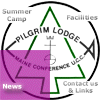 |
|
|

The Dome of St. Peter's Basilica from the top
of Castel Sant'Angelo
|
Photo Galleries:
Click below to enter a
gallery then click on
any photo in the
gallery to see a
larger image, or
press "slideshow"
to view all images. Use your browsers "back" button to return.
Rome
& Pompeii
Budapest
Orvietto
& Florence |
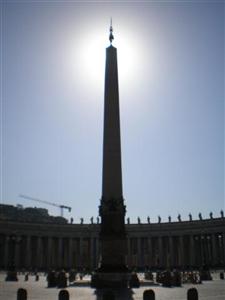 Four years ago my wife Deborah was accepted
into a program in support of women clergy. "Women Touched by Grace" is
funded through a grant from the Lily Foundation and facilitated by
Benedictine nuns from Our Lady of Grace
Monastery in Beech Grove, Indiana.
Twice a year, for four years Deb has journeyed to be with this group of 30
pastors and the nuns for ten day sessions working on spiritual renewal to
strengthen the church. The last session was planned in Italy in order
to explore the life of St. Benedict, the founder of the order.
Since Deb's trip was paid by the program, we cashed in some frequent flyer
miles to purchase my ticket. Originally we were going to have a week
together to explore Italy, then when Deb left for her program, I'd do my
thing in Rome. Realizing that two weeks is a long time for
six-year old Eric to be away from both Mom and Dad, we re-ordered the trip
so I'd go for five days first, then meet up with Deb for our vacation time,
and return home when she began her session. Four years ago my wife Deborah was accepted
into a program in support of women clergy. "Women Touched by Grace" is
funded through a grant from the Lily Foundation and facilitated by
Benedictine nuns from Our Lady of Grace
Monastery in Beech Grove, Indiana.
Twice a year, for four years Deb has journeyed to be with this group of 30
pastors and the nuns for ten day sessions working on spiritual renewal to
strengthen the church. The last session was planned in Italy in order
to explore the life of St. Benedict, the founder of the order.
Since Deb's trip was paid by the program, we cashed in some frequent flyer
miles to purchase my ticket. Originally we were going to have a week
together to explore Italy, then when Deb left for her program, I'd do my
thing in Rome. Realizing that two weeks is a long time for
six-year old Eric to be away from both Mom and Dad, we re-ordered the trip
so I'd go for five days first, then meet up with Deb for our vacation time,
and return home when she began her session.
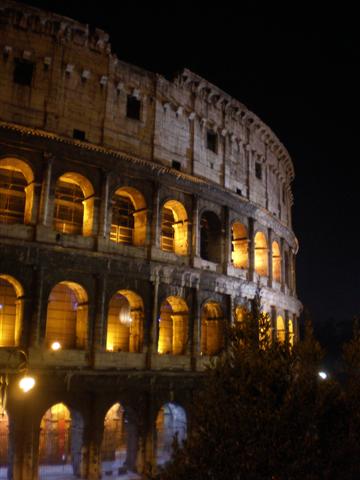 My
interest in exploring Rome began in earnest just two years ago during my
pilgrimage to Turkey. I traveled with
scholars Marcus Borg and John Dominic Crossan, both of whom have deeply affected me
through their work. It is Crossan's thesis on the development of
early Christianity, however, that I have pursued since the trip. Crossan's book,
In Search of Paul: How Jesus' Apostle Opposed Rome's Empire with God's
Kingdom, released just a week after our return from Turkey, co-authored with Jonathan Reed, piqued my curiosity about Rome. My
interest in exploring Rome began in earnest just two years ago during my
pilgrimage to Turkey. I traveled with
scholars Marcus Borg and John Dominic Crossan, both of whom have deeply affected me
through their work. It is Crossan's thesis on the development of
early Christianity, however, that I have pursued since the trip. Crossan's book,
In Search of Paul: How Jesus' Apostle Opposed Rome's Empire with God's
Kingdom, released just a week after our return from Turkey, co-authored with Jonathan Reed, piqued my curiosity about Rome.
Crossan's basic theory is that Paul (as
well as Jesus) preached in opposition to the empire. After Julius
Caesar's death, he was deified by the Senate. His adopted son Augustus became emperor and
was deemed "The Son of a God." "No," Crossan's Paul asserts, "Jesus is
the Son of God." More complex than simple wordplay, Crossan goes
on to posit that the Roman empire engaged in an all encompassing philosophy,
campaign and PR program of "peace through victory," which Jesus, and then,
Paul counter
with their own program "peace through justice." In Turkey, Crossan
brought us to site after site showing us art and inscriptions amidst the
ruins that clearly demonstrated the formula for the Pax Romani. His
book on Paul, draws on many of those same sites, but of course, Rome
itself is featured prominently. In
addition the book draws extensively on the Roman city of Pompeii preserved
in time by the eruption of Mt. Vesuvius in 79 AD as a typical Roman city
near the time of Paul.
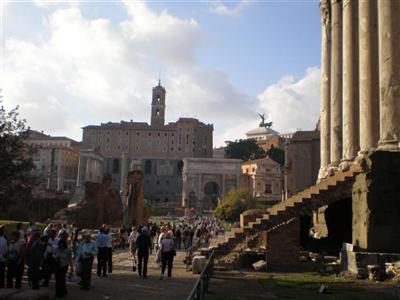 I arrived in Rome early in the morning
after an easy flight. I made my way to the monastery where I'd made
reservations, dumped my stuff, took a quick shower and jumped a city bus to
my first stop. The Arch of Titus is at one end of the Roman Forum, and
it just so happened that the bus stop was in front of the Colosseum. In
1983 I traveled through Europe with a companion and a backpack. I'd
made a two day stop in Rome, hampered by a near disastrous accident with my
eyes. Still, I'd managed to squeeze in the major tourist attractions.
Now, 23 years later I was here by myself with time, an education and an agenda.
The weather was unseasonably warm. T-shirt warm. The
Colosseum was magnificent of course in all its architectural glory and
reprehensible history. As I listened to a British group's guide, I
realized that the glory of Rome did not simply fall into decay. It was taken
apart piece by piece throughout history, stripped for its precious metals and
building materials. I arrived in Rome early in the morning
after an easy flight. I made my way to the monastery where I'd made
reservations, dumped my stuff, took a quick shower and jumped a city bus to
my first stop. The Arch of Titus is at one end of the Roman Forum, and
it just so happened that the bus stop was in front of the Colosseum. In
1983 I traveled through Europe with a companion and a backpack. I'd
made a two day stop in Rome, hampered by a near disastrous accident with my
eyes. Still, I'd managed to squeeze in the major tourist attractions.
Now, 23 years later I was here by myself with time, an education and an agenda.
The weather was unseasonably warm. T-shirt warm. The
Colosseum was magnificent of course in all its architectural glory and
reprehensible history. As I listened to a British group's guide, I
realized that the glory of Rome did not simply fall into decay. It was taken
apart piece by piece throughout history, stripped for its precious metals and
building materials.
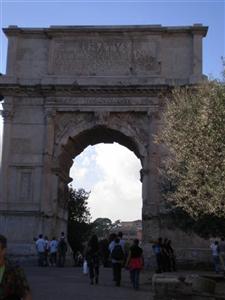 Upon leaving the Coliseum I walked to one
of the sites I was most eager to see: the Arch of Titus. Crossan
writes extensively
about this arch as part of his thesis on Roman Imperial
Theology but for me it made years of reading and class work real. It
was erected in 81-82 A.D. by Domician as tribute to Vespian's victory over
Egypt as well as to honor his Vespian's son Titus and his destruction of
Jerusalem in 70 AD. Inside the arch on the south side is a relief
showing the spoils of the Jewish temple being carted back to Rome. Fo Upon leaving the Coliseum I walked to one
of the sites I was most eager to see: the Arch of Titus. Crossan
writes extensively
about this arch as part of his thesis on Roman Imperial
Theology but for me it made years of reading and class work real. It
was erected in 81-82 A.D. by Domician as tribute to Vespian's victory over
Egypt as well as to honor his Vespian's son Titus and his destruction of
Jerusalem in 70 AD. Inside the arch on the south side is a relief
showing the spoils of the Jewish temple being carted back to Rome. Fo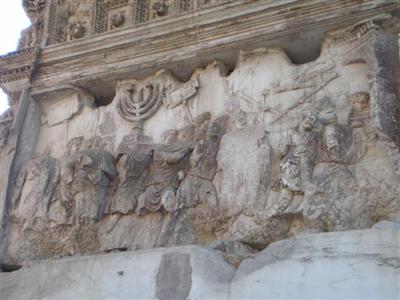 r years I've read and heard about the Jewish rebellion of 70 AD and the
crushing response of the empire who destroyed the temple. It is a
pivotal moment in both Jewish and Christian history. Somehow, seeing
the empire's victory etched in stone just ten years after the event suddenly
made all that theory real for me. I had a similar experience in
Ephesus in 1984 when suddenly much of the New Testament's historicity came
rushing at me. It is an overwhelming and ineffable experience to have
your perception on history shift in a single moment. r years I've read and heard about the Jewish rebellion of 70 AD and the
crushing response of the empire who destroyed the temple. It is a
pivotal moment in both Jewish and Christian history. Somehow, seeing
the empire's victory etched in stone just ten years after the event suddenly
made all that theory real for me. I had a similar experience in
Ephesus in 1984 when suddenly much of the New Testament's historicity came
rushing at me. It is an overwhelming and ineffable experience to have
your perception on history shift in a single moment.
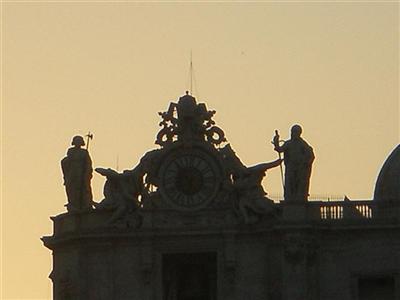 Still
reeling from having traveled so far, stunned by the spectacular warm day,
and still in awe the realization of history I began my stroll through the
Roman forum. I knew I had to sleep early that night so I spent the
rest of the day walking around Rome and mapping out the other sites I wanted
to see. I missed my family but enjoyed the feeling of being
able to go anywhere and do anything. Spontaneity is a good thing.
On my walk I realized that in addition to the history of the empire, I was
surrounded by the art and remains of thousands of years including the
renaissance, the enlightenment, and the entirety of church history. I
enjoyed the warm sunset and returned to the monastery and slept well. Still
reeling from having traveled so far, stunned by the spectacular warm day,
and still in awe the realization of history I began my stroll through the
Roman forum. I knew I had to sleep early that night so I spent the
rest of the day walking around Rome and mapping out the other sites I wanted
to see. I missed my family but enjoyed the feeling of being
able to go anywhere and do anything. Spontaneity is a good thing.
On my walk I realized that in addition to the history of the empire, I was
surrounded by the art and remains of thousands of years including the
renaissance, the enlightenment, and the entirety of church history. I
enjoyed the warm sunset and returned to the monastery and slept well.
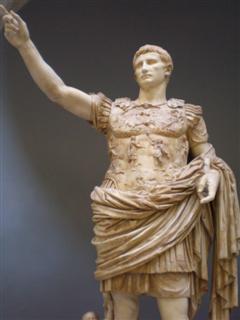 I
rose at 6 sharp and made my way by bus and subway across the city to be
among the first to line up for the Vatican Museums. It's difficult to take
in so much. I made sure to stop at Sistine Chapel and sought out the
Prima Porta statue of Augustus which was on my self produced Crossan
curriculum. I left the museum after about four hours, realizing one
could stay four weeks and not take it all in. Last time I was in Rome
I convinced my traveling partner that we should turn left out of the Vatican
Museum to get to St. Peter's I
rose at 6 sharp and made my way by bus and subway across the city to be
among the first to line up for the Vatican Museums. It's difficult to take
in so much. I made sure to stop at Sistine Chapel and sought out the
Prima Porta statue of Augustus which was on my self produced Crossan
curriculum. I left the museum after about four hours, realizing one
could stay four weeks and not take it all in. Last time I was in Rome
I convinced my traveling partner that we should turn left out of the Vatican
Museum to get to St. Peter's
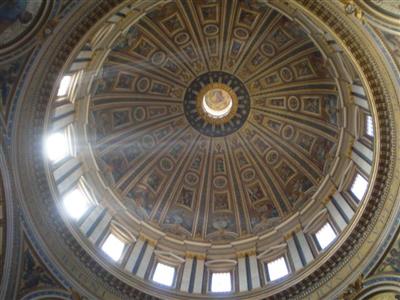 square
and ended up walking completely around Vatican City. This time I took
the shorter route to the right. What a mix of emotions St.
Peter's brings. Of all the myths and legends about relics, I can allow
myself the luxury of believing that Peter's remains may actually be under
that magnificent structure. That humans could create such a
masterpiece of art, architecture and awe inspiring vastness is astounding.
Its opulence is obscene and yet somehow it remains a holy and mystical
place. It was a prayerful experience. Since I'd never climbed up
to the massive dome to look down into the church from above, and out onto the
city from square
and ended up walking completely around Vatican City. This time I took
the shorter route to the right. What a mix of emotions St.
Peter's brings. Of all the myths and legends about relics, I can allow
myself the luxury of believing that Peter's remains may actually be under
that magnificent structure. That humans could create such a
masterpiece of art, architecture and awe inspiring vastness is astounding.
Its opulence is obscene and yet somehow it remains a holy and mystical
place. It was a prayerful experience. Since I'd never climbed up
to the massive dome to look down into the church from above, and out onto the
city from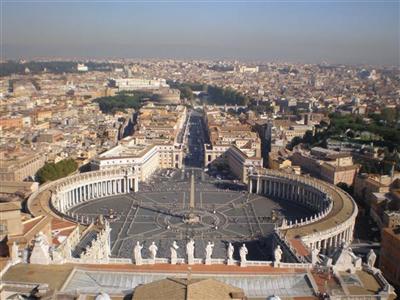 the top, I marched up the stairs. During the long journey up, having
to lean in from the edge of the dome and the narrow hallway I was listening
to the PL Staff mix of 2006 shuffled on my Ipod. Through the basilica
I'd heard the ethereal "I Can't Take It In" which could not have been more
appropriate and now on this endless stairway what should pop on but Bruce
Springsteen's "We Are Climbing Jacob's Ladder." As I stood outside on
the very top of the largest church in the world I looked out over Rome.
As I was gazing and contemplating all the triumphs and tragedies of the
church , taken with deep thoughts of human potential and failings, the Ipod
switched to a simple guitar riff and suddenly there was the dulcet tones of
Arthur Clayton Flanders III singing a song that only the staff of '06 knows.
I'm sure those around me were confident I was insane as I burst in laughter
for no apparent reason. It was a perfect moment.
the top, I marched up the stairs. During the long journey up, having
to lean in from the edge of the dome and the narrow hallway I was listening
to the PL Staff mix of 2006 shuffled on my Ipod. Through the basilica
I'd heard the ethereal "I Can't Take It In" which could not have been more
appropriate and now on this endless stairway what should pop on but Bruce
Springsteen's "We Are Climbing Jacob's Ladder." As I stood outside on
the very top of the largest church in the world I looked out over Rome.
As I was gazing and contemplating all the triumphs and tragedies of the
church , taken with deep thoughts of human potential and failings, the Ipod
switched to a simple guitar riff and suddenly there was the dulcet tones of
Arthur Clayton Flanders III singing a song that only the staff of '06 knows.
I'm sure those around me were confident I was insane as I burst in laughter
for no apparent reason. It was a perfect moment.
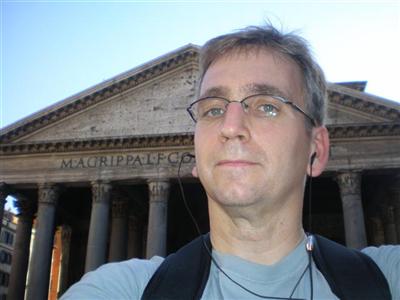 On my return to the ground I realized my jet
lag, two days of walking and my journey up to the sublime top of St. Peter's
dome left me feeling exhausted so I treated myself to a cab ride. It
felt good to sit even if just for a few minutes as well as letting someone
else figure out how to get to
The Pantheon, arguably the most well preserved of any ancient Roman building.
A temple to all gods, the Panetheon replaced two temples that existed before
it and has survived since Hadrian had it built (in spite of the inscription
on its portico crediting Marcus Agrippa) in about 120 AD. Its perfect
globe like dome includes the mighty opening, or oculus allowing a single
stream of sunlight, the structure's only source of light. Incredible. On my return to the ground I realized my jet
lag, two days of walking and my journey up to the sublime top of St. Peter's
dome left me feeling exhausted so I treated myself to a cab ride. It
felt good to sit even if just for a few minutes as well as letting someone
else figure out how to get to
The Pantheon, arguably the most well preserved of any ancient Roman building.
A temple to all gods, the Panetheon replaced two temples that existed before
it and has survived since Hadrian had it built (in spite of the inscription
on its portico crediting Marcus Agrippa) in about 120 AD. Its perfect
globe like dome includes the mighty opening, or oculus allowing a single
stream of sunlight, the structure's only source of light. Incredible.
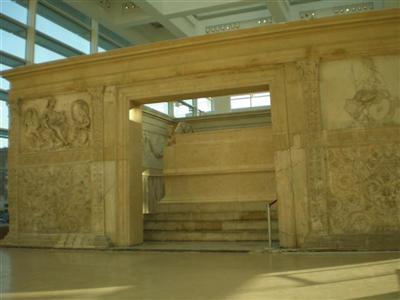 With my second wind I decided to walk to one
of the destinations I was most eager to see:
The Ara Pacis, Augustae
(Altar of Augustan Peace). The Ara Pacis was decreed by the
Senate on Augustus' victorious return from Spain and Gaul in 13 BCE and
dedicated in 9 BCE. It was
recovered from its original position (on which a renaissance palace had been
built) and moved to a site between the Tomb of Augustus and the Tiber in 1938 under the direction of Mussolini,
who wished to associate himself with Rome's greatest emperor. Parts of it
turned up in Florence, at the Louvre in Paris, and the Vatican. The
Louvre refused to give up its section and casts had to be made. Today it has
been moved and is encased in an earthquake proof, roofed structure. Crossan drew on the altar during his lectures in Turkey and dedicates a
chapter to it in his book on Paul. The annual sacrifice made there and
the altar itself is a testament that still shouts "First victory, then
peace." With my second wind I decided to walk to one
of the destinations I was most eager to see:
The Ara Pacis, Augustae
(Altar of Augustan Peace). The Ara Pacis was decreed by the
Senate on Augustus' victorious return from Spain and Gaul in 13 BCE and
dedicated in 9 BCE. It was
recovered from its original position (on which a renaissance palace had been
built) and moved to a site between the Tomb of Augustus and the Tiber in 1938 under the direction of Mussolini,
who wished to associate himself with Rome's greatest emperor. Parts of it
turned up in Florence, at the Louvre in Paris, and the Vatican. The
Louvre refused to give up its section and casts had to be made. Today it has
been moved and is encased in an earthquake proof, roofed structure. Crossan drew on the altar during his lectures in Turkey and dedicates a
chapter to it in his book on Paul. The annual sacrifice made there and
the altar itself is a testament that still shouts "First victory, then
peace."
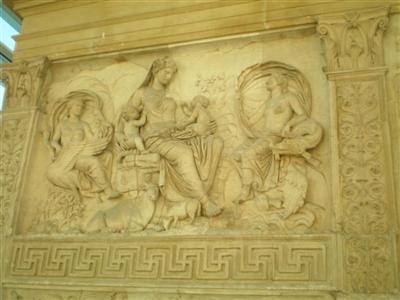
I circled the structure again and again and
then just sat and stared. I was renewed in my belief that to understand
Jesus and Paul, one must understand the Empire. The museum that
encases the altar was fascinating and I stayed until closing. I
learned that the Campus Martius was a field, dedicated to Mars, the God
of War, where Rome's army trained. The military field was marked at one end by the Pantheon
from which I'd just walked, and Augustus' Mausoleum on the other. Now there
is nothing but twisting narrow streets of Rome between them. The Ara
Pacis stood at the edge of the field in between the two.
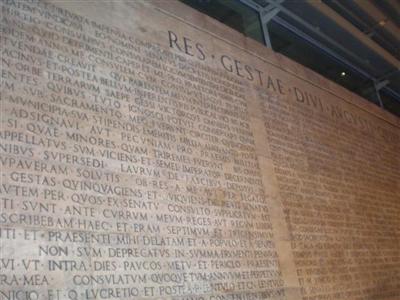 I left the building and stared at Res Gestae
Divi Augusti (Acts of the Divine Augustus) inscribed on the side of the
building. The museum is the second building to encase the Altar since 1938,
the wall with the inscription is all that remains of the first structure.
The inscription was another attempt by Mussolini to connect himself to
Augustus. He wanted to be buried in Augustus' mausoleum. History saw
otherwise. Looking across the modern copy the Res Gastae I reflected on
how this trip began in Turkey as I stood at the
Temple of Augustus in
Ankara, staring at the best preserved copy of the original, inscribed in
both Latin and Greek across that temple's walls. I left the building and stared at Res Gestae
Divi Augusti (Acts of the Divine Augustus) inscribed on the side of the
building. The museum is the second building to encase the Altar since 1938,
the wall with the inscription is all that remains of the first structure.
The inscription was another attempt by Mussolini to connect himself to
Augustus. He wanted to be buried in Augustus' mausoleum. History saw
otherwise. Looking across the modern copy the Res Gastae I reflected on
how this trip began in Turkey as I stood at the
Temple of Augustus in
Ankara, staring at the best preserved copy of the original, inscribed in
both Latin and Greek across that temple's walls.
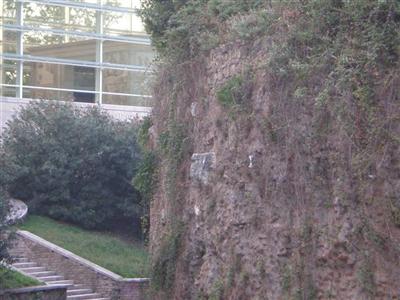 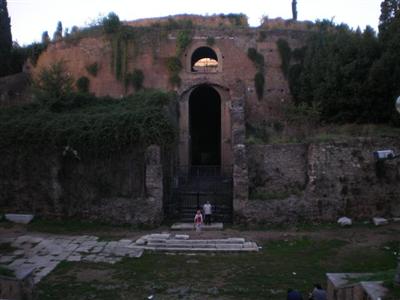 I crossed the street to the Mausoleum of
Augustus. A huge circular structure encompassing a city block. I
was stunned. The site seemed to be decaying before my very eyes.
How could Italy and Rome allow this central piece of world history to become
the slum at which I stared. Grass and weeds grew through it, the
public was barred, people were camped out living around its edge and the
place smelled of urine. The photo to the left shows the irony of the
care given to to the Ara Paci while the mausoleum crumbles. I crossed the street to the Mausoleum of
Augustus. A huge circular structure encompassing a city block. I
was stunned. The site seemed to be decaying before my very eyes.
How could Italy and Rome allow this central piece of world history to become
the slum at which I stared. Grass and weeds grew through it, the
public was barred, people were camped out living around its edge and the
place smelled of urine. The photo to the left shows the irony of the
care given to to the Ara Paci while the mausoleum crumbles.
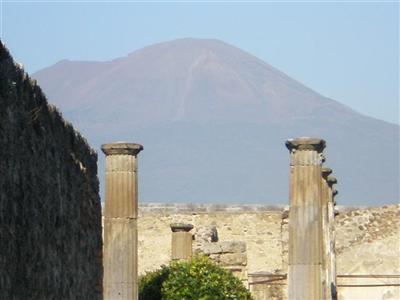 The next day I negotiated the 3 hour journey
to Ancient Pompeii. Another chapter in Crossan's book. I had no idea.
It's huge. And as I walked the streets, looking for sites written
about by Crossan I soon became overwhelmed and just took in as much as could
in a single day. Mount Vesuvius lurks over the entire site. It's
not to hard to imagine that it could be a problem. I thought of the
millions of people living around it today. The photo gallery on Rome
contains photos of this trip as well. The plaster casts of people
caught in the eruption stared eerily as I toured a city and sensed what life
was like for the first Christians. When people were buried in the ash,
they decomposed and left a perfect hollow image of themselves in the The next day I negotiated the 3 hour journey
to Ancient Pompeii. Another chapter in Crossan's book. I had no idea.
It's huge. And as I walked the streets, looking for sites written
about by Crossan I soon became overwhelmed and just took in as much as could
in a single day. Mount Vesuvius lurks over the entire site. It's
not to hard to imagine that it could be a problem. I thought of the
millions of people living around it today. The photo gallery on Rome
contains photos of this trip as well. The plaster casts of people
caught in the eruption stared eerily as I toured a city and sensed what life
was like for the first Christians. When people were buried in the ash,
they decomposed and left a perfect hollow image of themselves in the
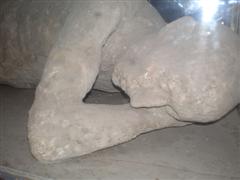 hardened stone. When excavators find such a hollow, they pump plaster
into it and create a perfect representation of that persons final moment.
The theatre, necropolis, stadium and baths are impressive to be sure, but
it's the everyday life aspects that gave me the newest perspective.
The bakery, the streets with deep chariot grooves, the homes, the shops, the
art, the graffiti on the wall, all frozen in time. hardened stone. When excavators find such a hollow, they pump plaster
into it and create a perfect representation of that persons final moment.
The theatre, necropolis, stadium and baths are impressive to be sure, but
it's the everyday life aspects that gave me the newest perspective.
The bakery, the streets with deep chariot grooves, the homes, the shops, the
art, the graffiti on the wall, all frozen in time.
The next day I arranged a tour so I could
relax a bit. I toured one of the Catacombs. There is mention of
these in Crossan but I have always wanted to see them. No photos were
allowed as they are considered holy ground. The tour included
several other stops, one at the best preserved aqueduct I've seen yet.
Adjusting to the time difference now, I spent a warm night walking Rome's
streets feeling the old world sense of community.
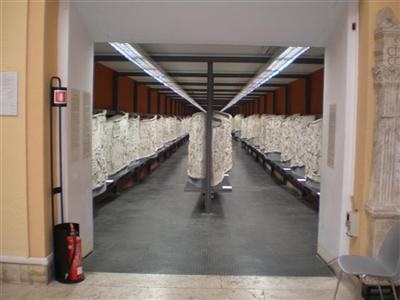 Before my trip I wrote to Dominic Crossan
and asked him about my itinerary. He suggested I visit the Museum of
Roman Civilization. He wanted me to start with it, but I had a hard time
finding it. With more familiarity with the landscape and public
transportation I finally located it. The bus led me outside the old
city to a modern section and let me out onto an empty, open plaza of
blinding white and towering, stark, modern buildings covered with modern
art. It was like stepping into another world. I made my Before my trip I wrote to Dominic Crossan
and asked him about my itinerary. He suggested I visit the Museum of
Roman Civilization. He wanted me to start with it, but I had a hard time
finding it. With more familiarity with the landscape and public
transportation I finally located it. The bus led me outside the old
city to a modern section and let me out onto an empty, open plaza of
blinding white and towering, stark, modern buildings covered with modern
art. It was like stepping into another world. I made my
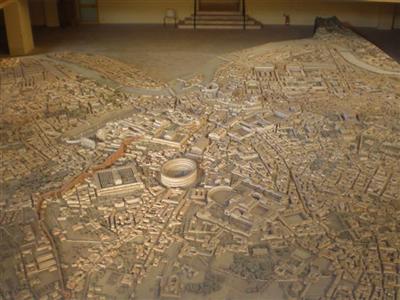 way
through feeling like a lone traveler on a deserted planet. The museum
was amazing. Each room represents a facet of Roman life: Law, Music,
Food, Art, War etc. The two most striking items were a plaster cast of the
entire column of Trajan depicting scene by scene of the major military
victories of Trajan in Dacia. Instead of a vertical, spiraling column,
each section is laid out horizontally. The final stop in the museum is
a map room depicting in detail the city of Rome around 300 AD at the time of
Constantine. It's overwhelming with meticulous detail. way
through feeling like a lone traveler on a deserted planet. The museum
was amazing. Each room represents a facet of Roman life: Law, Music,
Food, Art, War etc. The two most striking items were a plaster cast of the
entire column of Trajan depicting scene by scene of the major military
victories of Trajan in Dacia. Instead of a vertical, spiraling column,
each section is laid out horizontally. The final stop in the museum is
a map room depicting in detail the city of Rome around 300 AD at the time of
Constantine. It's overwhelming with meticulous detail.
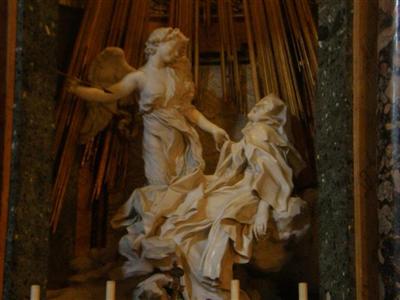 I'd achieved all of the stops I wanted to on
this trip and still had half a day left so engaged in some guilty pleasure.
I'd taken with me a copy of "Angels and Demons" by Dan Brown. It's the
first book about the character from the DaVinci Code. I'd re-read most of
the book on my way to and from Pompeii, now I hunted down I'd achieved all of the stops I wanted to on
this trip and still had half a day left so engaged in some guilty pleasure.
I'd taken with me a copy of "Angels and Demons" by Dan Brown. It's the
first book about the character from the DaVinci Code. I'd re-read most of
the book on my way to and from Pompeii, now I hunted down
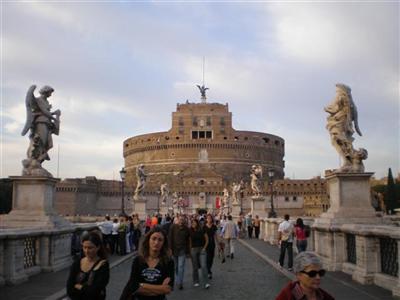 each site, each
sculpture that the book dealt with and read those sections at the site.
One stop led me to an enchanted lunch and coffee in the Piazza Navona
complete with street performances. The penultimate scene of the book is at the magnificent
Castel St. Angela so
I walked over expecting to read outside its gates. I found it
was open until 8 pm so I bought my ticket and in I went. It was built
in 145 AD as Emperor Hadrian's tomb, later it became a fortress and a
castle, the Pope's secret quarters and a torture chamber. I walked up
the ramp that circles the inside to the top where I sat and read the book
and watched the sunset over Rome. It was the perfect ending to an
amazing five days. each site, each
sculpture that the book dealt with and read those sections at the site.
One stop led me to an enchanted lunch and coffee in the Piazza Navona
complete with street performances. The penultimate scene of the book is at the magnificent
Castel St. Angela so
I walked over expecting to read outside its gates. I found it
was open until 8 pm so I bought my ticket and in I went. It was built
in 145 AD as Emperor Hadrian's tomb, later it became a fortress and a
castle, the Pope's secret quarters and a torture chamber. I walked up
the ramp that circles the inside to the top where I sat and read the book
and watched the sunset over Rome. It was the perfect ending to an
amazing five days.
I went to the airport to meet Deborah. I
put on a tie. I bought a rose. I stood at the international gate
and waited. She never showed. A windy day in Portland had thrown
her travel plans into the blender. She was stuck in Paris, which was
not on her original itinerary. Instead of arriving at 11 AM she was now due
at 5 PM, five minutes after our flight to Budapest was scheduled to take
off. A day of expensive phone calls and airport nightmares later we
hooked up at the airport in Budapest with all our luggage and Janos.
Deb was exhausted but in good spirits nonetheless.
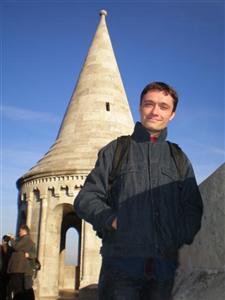 Janos
Meszar is from the Ukraine, although culturally Hungarian. He is
attending University in Budapest. He spent the last three summers as
maintenance staff at PL and is loved by all. Janos is eternally
positive, willing to do whatever needs to be done, hates to be idle and has
a magical way with children and animals. Last summer when I knew I
would be traveling, I offhandedly asked Janos how long it was from Rome to
Budapest. One thing led to another and now here we were, ready for a
new adventure. We stayed in his dorm, formerly a barracks for Russian
soldiers. Janos
Meszar is from the Ukraine, although culturally Hungarian. He is
attending University in Budapest. He spent the last three summers as
maintenance staff at PL and is loved by all. Janos is eternally
positive, willing to do whatever needs to be done, hates to be idle and has
a magical way with children and animals. Last summer when I knew I
would be traveling, I offhandedly asked Janos how long it was from Rome to
Budapest. One thing led to another and now here we were, ready for a
new adventure. We stayed in his dorm, formerly a barracks for Russian
soldiers.
Janos was the perfect host. He showed us all
around the city which is stunningly beautiful. He filled us in on the
history as well. It just so happened that we were there during the
50th anniversary of a
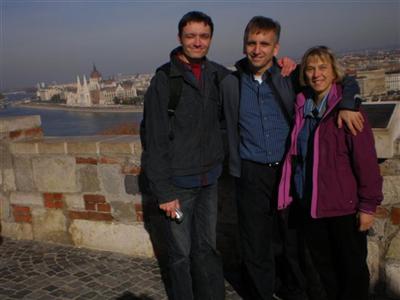 Hungarian
revolt. In 1955, still occupied by the soviets after World War II the
people revolted and were put down mercilessly (it reminds me of Rome
crushing the revolt in Jerusalem) ending with Hungary entrenched in the Soviet
Union. One of our stops was a museum set up to remember that event.
Even though it was closed, the faces and stories of the victims was a
sobering moment. Janos took us to the Parliament building where the recent
uprisings over government corruption occurred. We also toured an ancient cathedral and castle.
We crossed the Danube and walked to Hero's Square where a thousand years of
kings greeted us. As fascinating as the tour of Budapest was, our favorite
thing was just being with Janos and seeing the world in which he lives.
We were there two days when we hugged Janos and returned to Rome. Hungarian
revolt. In 1955, still occupied by the soviets after World War II the
people revolted and were put down mercilessly (it reminds me of Rome
crushing the revolt in Jerusalem) ending with Hungary entrenched in the Soviet
Union. One of our stops was a museum set up to remember that event.
Even though it was closed, the faces and stories of the victims was a
sobering moment. Janos took us to the Parliament building where the recent
uprisings over government corruption occurred. We also toured an ancient cathedral and castle.
We crossed the Danube and walked to Hero's Square where a thousand years of
kings greeted us. As fascinating as the tour of Budapest was, our favorite
thing was just being with Janos and seeing the world in which he lives.
We were there two days when we hugged Janos and returned to Rome.
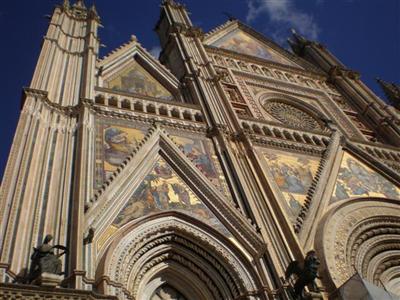 There
we rented a car and traveled to Orvietto, a city recommended to us by Jay
and Martha Young (Jay was the driving force behind
the Labyrinth). It was a highlight of
our time together. The cathedral
in the center of this small city is indescribably ornate and beautiful.
The whole city sits on top of a rock outcropping and towers over the plains
around it which were once the ocean floor. The art was incredible as
was the tour of the underground. In Orvietto I became more cognitive
of the fact that
the layered history of Italy doesn't begin with the Romans but reaches
further to the Etruscans. We stayed in another monastery and upon
leaving had a little adventure when the teeny creaky elevator stopped with a
sudden BANG and the doors opened to reveal a concrete wall. We were
stuck for about twenty minutes while
Sister Stella
ran to the chapel to pray for us. (She was so cute!) In spite of her
intercession with the divine, I will confess to a bit of interior
claustrophobic panic as I realized there was no emergency door and we were truly trapped. Deb, of
course, was cool as a cucumber. There
we rented a car and traveled to Orvietto, a city recommended to us by Jay
and Martha Young (Jay was the driving force behind
the Labyrinth). It was a highlight of
our time together. The cathedral
in the center of this small city is indescribably ornate and beautiful.
The whole city sits on top of a rock outcropping and towers over the plains
around it which were once the ocean floor. The art was incredible as
was the tour of the underground. In Orvietto I became more cognitive
of the fact that
the layered history of Italy doesn't begin with the Romans but reaches
further to the Etruscans. We stayed in another monastery and upon
leaving had a little adventure when the teeny creaky elevator stopped with a
sudden BANG and the doors opened to reveal a concrete wall. We were
stuck for about twenty minutes while
Sister Stella
ran to the chapel to pray for us. (She was so cute!) In spite of her
intercession with the divine, I will confess to a bit of interior
claustrophobic panic as I realized there was no emergency door and we were truly trapped. Deb, of
course, was cool as a cucumber.
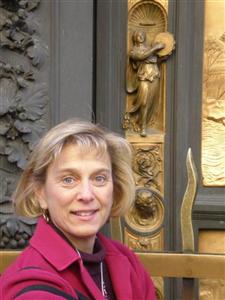 We
continued on to Florence where the first century gave way to the
renaissance. I'd also been in Florence briefly but my memory was dim
and besides, one can never gaze at Michelangelo's David too many times.
Whenever we travel Deb and I look for angels playing tambourines in the art
since that is her musical gift she developed as a member of the Mob of
Angels. I'd photographed about 5 in Rome but in Florence we could barely
keep up. We were there for the ceremonies marking the 40th
anniversary of a flood that devastated the city and happened upon a huge
celebration with dancing medieval flag throwers (!) outside the Uffizi
Museum as we approached to get in line. The food was amazing, as was the
art, architecture and history. We'd stroll into any of the hundreds of
churches to find overwhelmingly beautiful interiors. We again stayed in
a monastery. It was also nice to just be together so much on a
vacation we will both always cherish. We
continued on to Florence where the first century gave way to the
renaissance. I'd also been in Florence briefly but my memory was dim
and besides, one can never gaze at Michelangelo's David too many times.
Whenever we travel Deb and I look for angels playing tambourines in the art
since that is her musical gift she developed as a member of the Mob of
Angels. I'd photographed about 5 in Rome but in Florence we could barely
keep up. We were there for the ceremonies marking the 40th
anniversary of a flood that devastated the city and happened upon a huge
celebration with dancing medieval flag throwers (!) outside the Uffizi
Museum as we approached to get in line. The food was amazing, as was the
art, architecture and history. We'd stroll into any of the hundreds of
churches to find overwhelmingly beautiful interiors. We again stayed in
a monastery. It was also nice to just be together so much on a
vacation we will both always cherish.
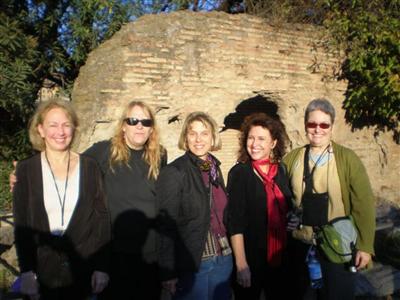 We
drove back to Rome and had a bit of fiasco finding a place to stay that ate
up our last day. When we woke and went to airport we found my flight
had been changed and I'd missed it. More travel drama and I ended up
booked on the next day's flight. So, I went with Deb to the start of
her Women Touched By Grace program and stayed with her at the Benedictine
monestary giving me the pleasure of meeting most of the women I'd heard so much
about. I was up before the sun the next morning as I left Deb
to her program and jumped the train to the airport for an uneventful flight
back. We
drove back to Rome and had a bit of fiasco finding a place to stay that ate
up our last day. When we woke and went to airport we found my flight
had been changed and I'd missed it. More travel drama and I ended up
booked on the next day's flight. So, I went with Deb to the start of
her Women Touched By Grace program and stayed with her at the Benedictine
monestary giving me the pleasure of meeting most of the women I'd heard so much
about. I was up before the sun the next morning as I left Deb
to her program and jumped the train to the airport for an uneventful flight
back.
The trip renewed my interest in history and
focused my understanding of the church. I'll still take a simple New
England Congregational (I mean UCC) church over the grandeur of the 500
churches in Rome. I am richly blessed and grateful for the opportunity
to experience so much in this life.
Photo
Galleries:
Rome
& Pompeii
Budapest
Orvietto
& Florence
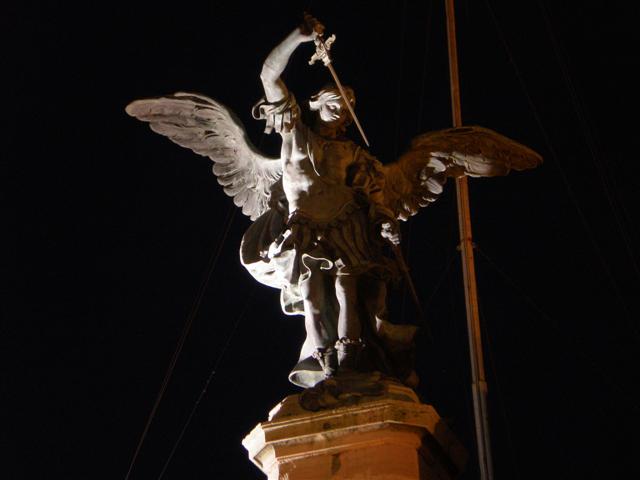
Back to Director's
Log
To Pilgrim
Lodge Home Page
|
 |

























